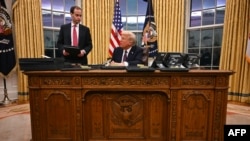ປີ 2020 ເປັນຂີດໝາຍຄົບຮອບ 100 ປີຂອງບົດເພີ້ມເຕີມລັດຖະທຳ ມະນູນສະຫະລັດ ຂໍ້ທີ 19 ທີ່ອະນຸຍາດໃຫ້ພວກແມ່ຍິງ ມີສິດລົງຄະແນນສຽງ ເລືອກຕັ້ງ. ຫໍພິພິຕະພັນຕ່າງໆໃນເຂດນະ ຄອນຫຼວງ ວໍຊິງຕັນ ແມ່ນກຳລັງສະ ເຫຼີມສະຫຼອງ ພ້ອມດ້ວຍການວາງສະແດງທີ່ເລົ່າເລື່ອງ ກ່ຽວກັບ ວິທີທີ່ແມ່ຍິງ ໄດ້ຕໍ່ສູ້ເພື່ອສິດມິໃນການເລຶືອກຕັ້ງແນວໃດ. ນັກຂ່າວວີໂອເອ ແມັກຊິມ ມອສ- ກາລກອຟ ມີລາຍງານເພີ່ມເຕີມຈາກຫໍພິພິຕະພັນປະຫວັດສາດແຫ່ງຊາດ ອາ ເມຣິກັນ ເຊິ່ງ ພຸດທະສອນ ຈະນຳລາຍລະອຽດມາສະເໜີທ່ານໃນອັນດັບຕໍ່ໄປ.
ບັນດາແມ່ຍິງ ອາເມຣິກັນທີ່ຕໍ່ສູ້ເພື່ອສິດທິໃນການເລືອກຕັ້ງໄດ້ເອີ້ນຕົນເອງວ່າ ແມ່ຍິງຜູ້ທີ່ສະ ໜັບສະໜູນການໃຫ້ແມ່ຍິງມີສິດເລືອກຕັ້ງ. ເຂົາເຈົ້າໄດ້ແຕ້ມ ປ້າຍຕ່າງໆ, ມັດຕົນເອງໃສ່ທາງ ລົດໄຟ, ໂຈມຕີຕຳຫຼວດດ້ວຍຄັນຮົ່ມ, ບຸກເຂົ້າ ໄປໃນຮ້ານຂາຍເຄື່ອງ ແລະ ຫ້ອງການລັດຖະ ບານ, ຈັດການຊຸມນຸມ ແລະ ປະທ້ວງ, ທຸກຢ່າງແມ່ນການຕໍ່ສູ້ຂອງເຂົາເຈົ້າ.
ທ່ານນາງ ລີຊາ ແກຣດດີ ຜູ້ກຳກັບງານວາງສະແດງໄດ້ກ່າວວ່າ “ການວາງສະແດງນີ້ໃຫ້ຂໍ້ຄິດ ເຫັນ ກ່ຽວກັບ ເລື່ອງດັ້ງເດີມທີ່ພວກເຮົາຈື່ ກ່ຽວກັບ ສິດທິການ ເລືອກຕັ້ງ ນັ້ນແມ່ນເລື່ອງທີ່ພວກ ເຮົາໄດ້ຖືກສອນ ກ່ຽວກັບ ທ່ານນາງ ຊູຊານ ບີ ແອນໂທນີ ທີ່ນຳໜ້າກຸ່ມແມ່ຍິງທີ່ກ້າຫານທັງຫຼາຍ ໃນການດີ້ນຮົນຕໍ່ສູ່ທີ່ດົນ ນານ ສຳລັບການເລືອກຕັ້ງ. ແລະ ມັນແມ່ນເລື່ອງທີ່ວິເສດຫຼາຍ ແລະ ມັນບໍ່ ແມ່ນວ່າ ມັນບໍ່ແມ່ນຄວາມຈິງ ແຕ່ມັນໄດ້ຕັດຄົນຈຳນວນຫຼວງຫຼາຍອອກໄປ.”
ແມ່ຍິງພວກນີ້ ຜູ້ທີ່ໄດ້ຕໍ່ສູ້ຄຽງບ່າຄຽງໄຫຼ່ກັນ ແລະ ໄດ້ຮັບແຮງກະຕຸ້ນນັ້ນ ໄດ້ເປັນສູນກາງຂອງ ງານວາງສະແດງຢູ່ຫໍພິພິຕະພັນປະຫວັດສາດແຫ່ງຊາດ ອາເມຣິກັນ ເປັນຕົ້ນມາ.
ວັດຖຸສິ່ງຂອງສ່ວນຕົວຂອງເຂົາເຈົ້າ, ປ້າຍທີ່ຖືກແຕ້ມດ້ວຍມື, ປ້າຍຊື່, ຮູບ, ເອກະສານ ແລະ ແມ່ນກະທັ້ງໄມ້ຄ້ອນຕີຂອງທ່ານນາງ ແນນຊີ ເພໂລຊີ ປະທານສະພາຕໍ່າ ສະຫະລັດ ທີ່ເປັນ ແມ່ຍິງຄົນທຳອິດ, ທຸກຢ່າງນີ້ ແມ່ນສ່ວນ ນຶ່ງຂອງງານວາງສະແດງ ເປັນສ່ວນນຶ່ງຂອງການຕໍ່ ສູ້ທີ່ຍາວນານ ແລະ ຍັງຕໍ່ ສູ້ເພື່ອສິດທິພົນລະເຮືອນ ແລະ ການເມືອງ.
ທ່ານນາງ ລີຊາ ແກຣດດີ ກ່າວວ່າ “ໃນງານວາງສະແດງນີ້ພວກເຮົາຢາກວາງ ສະແດງເລື່ອງ ລາວຂອງຄົນທີ່ພວກເຮົາຮູ້ ແລະ ຜູ້ເປັນແບບຢ່າງທີ່ວິເສດ ທີ່ຫໍພິ ພິຕະພັນເກັບສະສົມ ກ່ຽວກັບ ຄົນພວກນັ້ນ ແລະ ວາງສົມທຽບມັນກັບ ຄົນທີ່ ພວກເຮົາຄຸ້ນເຄີຍໜ້ອຍກວ່າ. ຄົນຄືທ່ານນາງ ມາໂບ ລີ ເຊິ່ງແມ່ນແມ່ຍິງໜຸ່ມ ອາເມຣິກັນ ເຊື້ອສາຍ ຈີນ ຜູ້ທີ່ໄດ້ຕໍ່ສູ້ເພື່ອສິດທິໃນການເລືອກ ຕັ້ງໃນນະຄອນ ນິວຢອກ, ເຖິງແມ່ນວ່າ ລາວເອງເປັນຄົນອາເມຣິກັນເຊື້ອສາຍ ຈີນ ທີ່ບໍ່ໄດ້ຖືກ ພິຈາລະນາວ່າເປັນຄົນອາເມຣິກັນ ຈະບໍ່ໄດ້ຮັບຜົນປະໂຫຍດຈາກການ ລົງຄະ ແນນສຽງ ເມື່ອລັດຖະທຳມະນູນຖືກຮັບຜ່ານກໍຕາມ.”
ບົດເພີ້ມຕື່ມລັດຖະທຳມະນູນ ສະຫະລັດ ຂໍ້ທີ 19 ທີ່ອະນຸຍາດໃຫ້ແມ່ຍິງມີສິດ ລົງຄະແນນສຽງ ເລືອກຕັ້ງ ໄດ້ຖືກຮັບຮອງເອົາໃນປີ 1919, ແມ່ນກະທັ້ງທີ່ມັນ ໄດ້ຖືກສະເໜີເປັນ ຄັ້ງທຳອິດໃນປີ 1878 ກໍຕາມ.
ຍ້ອນບັນດາແມ່ຍິງທີ່ໄດ້ຕໍ່ສູ້ເພື່ອສິດທິໃນການເລືອກຕັ້ງ, ລວມທັງທ່ານນາງ ຊູຊານ ບີ ແອນໂທ ນີ ແລະ ທ່ານນາງ ເອລິຊາເບັດ ເຄດີ ສແຕນຕັນ ນັ້ນ, ລັດຖະທຳມະນູນຂໍ້ດັ່ງກ່າວຈຶ່ງໄດ້ຖືກ ໃຫ້ສັດຕະຍາບັນໃນທີ່ສຸດໃນວັນທີ 18 ສິງຫາ 1920.
ທ່ານນາງ ລີຊາ ແກຣດດີ ກ່າວວ່າ “ພວກເຮົາໄດ້ສົມທຽບສິດທິໃນການເລືອກ ຕັ້ງ ກັບປີ 1977 ແລະ ກອງປະຊຸມໃຫຍ່ແມ່ຍິງແຫ່ງຊາດໃນປີ 1977 ທີ່ຈັດ ຂຶ້ນໃນ ນະຄອນ ຮູສຕັນ ລັດ ເທັກຊັສ ບ່ອນທີ່ບັນດາແມ່ຍິງໄດ້ເຕົ້າໂຮມກັນ ແລະ ໄດ້ສ້າງແຜນການນິຕິບັນຍັດ ທີ່ເຂົາເຈົ້າໄດ້ສົ່ງໃຫ້ ປະທານາທິບໍດີ ແລະ ລັດຖະ ສະພາເພື່ອປະກາດໃຊ້ສຳລັບສິດທິຂອງບັນດາແມ່ຍິງ. ແລະ ການເດີນ ຂະບວນຂອງພວກແມ່ຍິງໃນປີ 2017 ທີ່ໄດ້ເຮັດໃຫ້ການເຄື່ອນໄຫວຂອງບັນ ດາແມ່ ຍິງຟື້ນຄືນຊີບມາໃໝ່. ແລະ ໃນການເຄື່ອນໄຫວສະໄໝໃໝ່ທັງສອງ ນັ້ນ, ບັນດານັກເຄື່ອນໄຫວ ໄດ້ຫວນກັບຄືນໄປຫາ ແມ່ຍິງຜູ້ທີ່ສະໜັບສະໜູນ ການໃຫ້ແມ່ຍິງ ມີສິດເລືອກຕັ້ງນັ້ນເປັນແຮງ ບັນດານໃຈ ແລະ ເປັນແບບຢ່າງ.”
ການເດີນຂະບວນຂອງບັນດາແມ່ຍິງໃນປີ 2017 ໄດ້ຈັດຂຶ້ນໃນຫຼາຍຕົວເມືອງ ທົ່ວ ສະຫະລັດ ຫຼັງຈາກການສາບານຕົນເຂົ້າຮັບຕຳແໜ່ງຂອງປະທານາທິບໍດີ ດໍໂນລ ທຣຳ. ຫຼາຍກວ່າ 5 ລ້ານ ຄົນໄດ້ເຂົ້າຮ່ວມໃນການເດີນຂະບວນ, ເຮັດ ໃຫ້ມັນ ເປັນການປະທ້ວງທີ່ໃຫຍ່ທີ່ສຸດພາຍໃນມື້ ດຽວ ໃນປະຫວັດສາດ ຂອງ ສະຫະລັດ.
ທ່ານນາງ ແຄຼ ເຈີຣີ ຫົວໜ້າງານວາງສະແດງເວົ້າວ່າ “ໃນການເດີນຂະບວນ ຂອງບັນດາແມ່ຍິງ ໃນປີ 2017 ພວກເຮົາໄດ້ເຫັນແມ່ຍິງຖືປ້າຍ ທີ່ພວກເຂົາເຈົ້າ ໄດ້ກ່າວຢໍ້າເຖິງການເຄື່ອນໄຫວ ສິດທິໃນການເລືອກຕັ້ງ. ການເດີນຂະບວນໃນປີ 1848-2017 ໄດ້ເລີ່ມຂຶ້ນດ້ວຍທ່ານນາງ ເຊເນກາ ຟອລສ໌, ເຊິ່ງແມ່ນຄັ້ງທຳ ອິດ ທີ່ສິດທິໃນການລົງຄະແນນສຽງຂອງບັນດາແມ່ຍິງ ໄດ້ຖືກສະໜັບສະໜູນ ຢ່າງເປີດເຜີຍໃນປະເທດນີ້.”
ການວາງສະແດງຢູ່ທີ່ຫໍພິພິຕະພັນປະຫວັດສາດແຫ່ງຊາດ ອາເມຣິກັນ ມີວັດຖຸຕ່າງໆຫຼາຍກວ່າ 60 ຢ່າງຖືກນຳມາວາງສະແດງ ຊຶ່ງບາງອັນເປັນຂອງຂວັນ ໃຫ້ແກ່ສະຖາບັນສມິດໂຊນຽນ ໂດຍ ສະມາຄົມແມ່ຍິງຮຍກຮ້ອງເອົາສິດປ່ອນບັດ ຢ້ອນຄືນໄປເມື່ອປີ 1920.
The year 2020 marks the 100th anniversary ofthe U.S. Constitution's 19th Amendment granting women the right to vote . Museums in the Washington DC area are celebrating with exhibitions that tell the story of how women fought for voting rights.Maxim Moskalkov has more from the National Museum of American History.
American women fighting for the right to vote called themselves Suffragettes, from the word Suffrage, which means to vote.
They painted signs, chained themselves to rails, attacked policemen with umbrellas and stormed stores and government offices, organized rallies and demonstrationsall part of their fight.
"This exhibit looks at the traditional story that we all remember of suffrageand that's the story we were taught of Susan B. Anthony leading a gallant band of women on a long struggle for the vote. And thats a wonderful story, and it's not that it's not true, but it leaves out so many people…"
These women who fought side-by-side and have made gains since then are the center of the exhibit at the National Museum of American History.
Their personal belongings, hand-painted banners, badges, portraits and documents, even the wooden hammer of Nancy Pelosi the first female Speaker of the United States House of Representativesall these items are part of the exhibit and part of the long battle women waged and still wage in their fight for civil and political rights.
In this exhibit we wanted to juxtapose the story of the people we know and the wonderful icons that the museum has in the collection about those peopleand to juxtapose them with the people that we're less familiar with. People like Mable Leea young Chinese-American woman who fought for suffrage in New York City, although she herselfbecause Chinese Americans were not considered citizenswould not benefit from the vote when the amendment was passed."
The 19th Amendment to the US Constitution that granted women the right to vote was adopted in 1919, even though it was first proposed in 1878.
Thanks to women who fought for voting rightsSusan B. Anthony and Elizabeth Cady Stanton among themthe amendment was finally ratified on August 18, 1920.
"We've juxtaposed suffrage with 1977 and the National Women's Conference in 1977 held in Houston, Texas, where women met together and came up with a legislative agenda that they sent to the President and Congress to enact for women's rights. And the 2017 Women's March, which was seen as a revitalization of the women's movement. And in both of those modern movements, the activists harking back to the suffragettesas inspiration and as role models."
The 2017 Women's March took place in multiple cities across the US after the inauguration of President Donald Trump. Over 5 million people took part in the march making it the largest single-day protest in the American history.
"In the Women's March in 2017 we actually saw women carrying posters where they were echoing the suffrage movement, the 1848-2017 sash starts with Seneca Falls, which was the first time that women suffrage was publicly advocated by women in this country."
"Women have claimed their power and reclaimed the story and taken the narrative back from the prevailing narrative. One of the ways that it happened in 2017 was with the pussycat that you can see in this exhibit. It was an attempt to reclaim the word that was sometimes derogatory and make it something that would be celebrated and powerful."
The exhibit at the National Museum of American History has more than 60 objects on display, some of which were gifted to the Smithsonian by the National Woman Suffrage Association back in the 1920.



